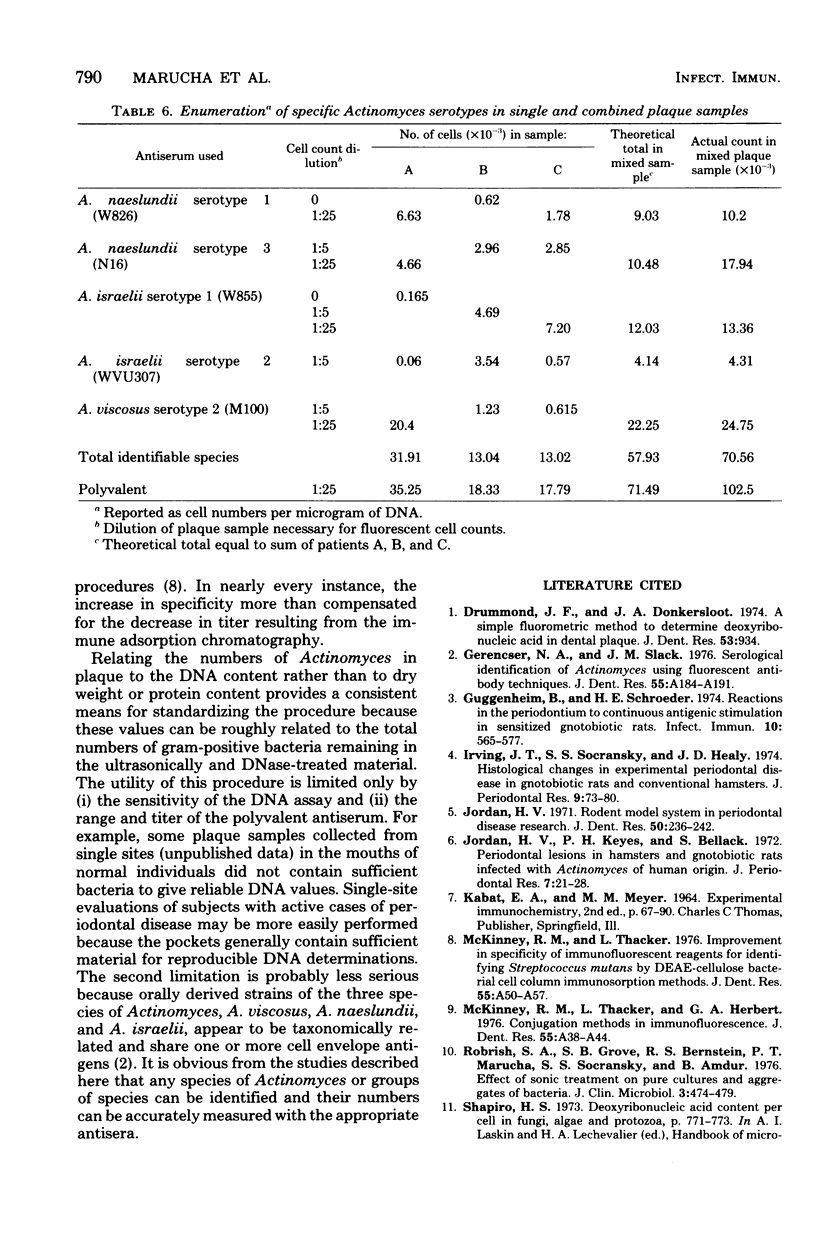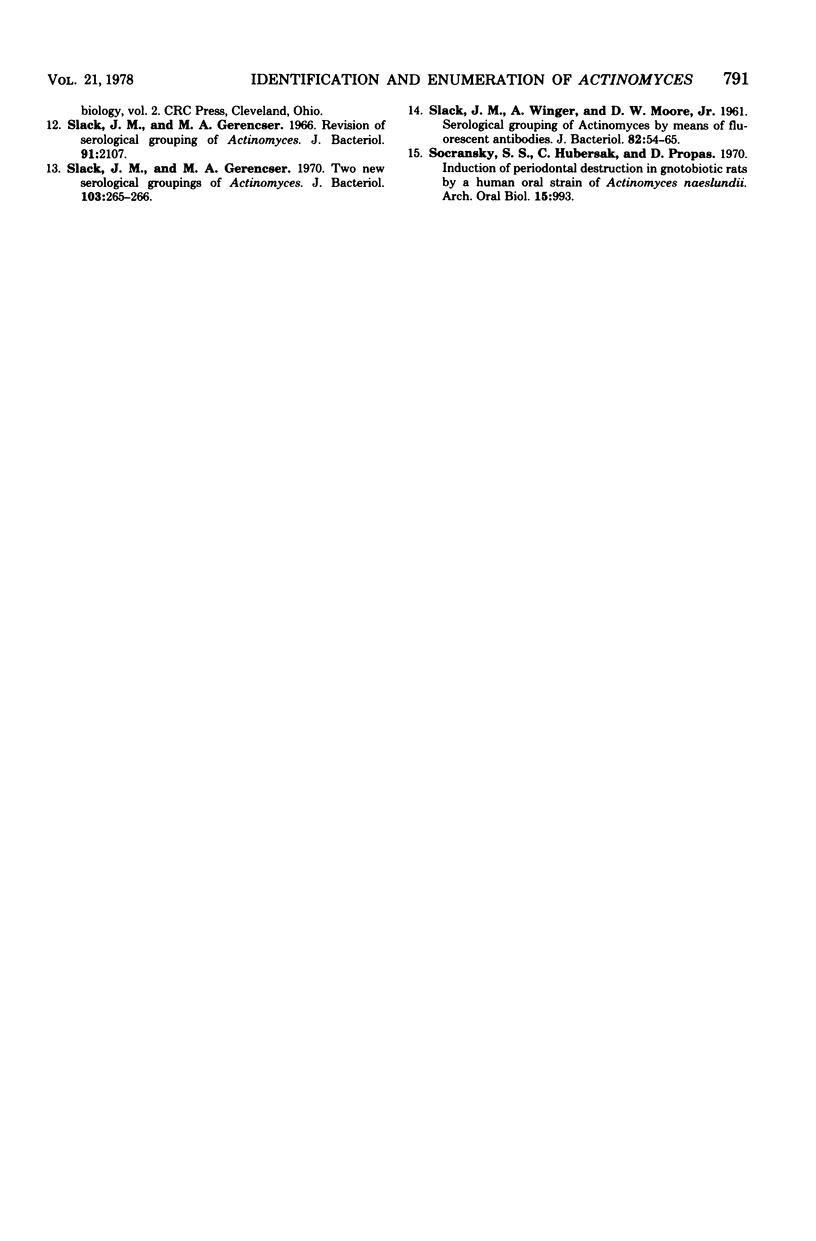Abstract
Serotype-specific antisera prepared against whole cells of Actinomyces viscosus, A. naeslundii, and A. israeli were labeled with fluorescein dye and used to detect and quantitate antigenically related microorganisms in human dental plaque. By relating the DNA content of the dental plaque microflora to the number of Actinomyces present in the plaque samples, a reproducible method was developed for specifically enumerating five serotypic representatives of this genus found in human plaque.
Full text
PDF





Selected References
These references are in PubMed. This may not be the complete list of references from this article.
- Drummond J. F., Donkersloot J. A. A simple fluorometric method to determine deoxyribonucleic acid in dental plaque. J Dent Res. 1974 Jul-Aug;53(4):934–934. doi: 10.1177/00220345740530042701. [DOI] [PubMed] [Google Scholar]
- Gerencser M. A., Slack J. M. Serological identification of Actinomyces using fluorescent antibody techniques. J Dent Res. 1976 Jan;55:A184–A191. doi: 10.1177/002203457605500110011. [DOI] [PubMed] [Google Scholar]
- Guggenheim B., Schroeder H. E. Reactions in the periodontium to continuous antigenic stimulation in sensitized gnotobiotic rats. Infect Immun. 1974 Sep;10(3):565–577. doi: 10.1128/iai.10.3.565-577.1974. [DOI] [PMC free article] [PubMed] [Google Scholar]
- Irving J. T., Socransky S. S., Heeley J. D. Histological changes in experimental periodontal disease in gnotobiotic rats and conventional hamsters. J Periodontal Res. 1974;9(2):73–80. doi: 10.1111/j.1600-0765.1974.tb00656.x. [DOI] [PubMed] [Google Scholar]
- Jordan H. V., Keyes P. H., Bellack S. Periodontal lesions in hamsters and gnotobiotic rats infected with actinomyces of human origin. J Periodontal Res. 1972;7(1):21–28. doi: 10.1111/j.1600-0765.1972.tb00627.x. [DOI] [PubMed] [Google Scholar]
- Jordan H. V. Rodent model systems in periodontal disease research. J Dent Res. 1971 Mar-Apr;50(2):236–242. doi: 10.1177/00220345710500021301. [DOI] [PubMed] [Google Scholar]
- Mc Kinney R. M., Thacker L. Improvement in specificity of immunofluorescent reagents for identifying Streptococcus mutans by DEAE-cellulose-bacterial cell column immunosorption methods. J Dent Res. 1976 Jan;55:A50–A57. doi: 10.1177/002203457605500121011. [DOI] [PubMed] [Google Scholar]
- McKinney R., Thacker L., Hebert G. A. Conjugation methods in immunofluorescence. J Dent Res. 1976 Jan;55:A38–A44. doi: 10.1177/002203457605500117011. [DOI] [PubMed] [Google Scholar]
- Robrish S. A., Grove S. B., Bernstein R. S., Marucha P. T., Socransky S. S., Amdur B. Effect of sonic treatment on pure cultures and aggregates of bacteria. J Clin Microbiol. 1976 May;3(5):474–479. doi: 10.1128/jcm.3.5.474-479.1976. [DOI] [PMC free article] [PubMed] [Google Scholar]
- Slack J. M., Gerencser M. A. Revision of serological grouping of Actinomyces. J Bacteriol. 1966 May;91(5):2107–2107. doi: 10.1128/jb.91.5.2107-.1966. [DOI] [PMC free article] [PubMed] [Google Scholar]
- Slack J. M., Gerencser M. A. Two new serological groups of Actinomyces. J Bacteriol. 1970 Jul;103(1):265–266. doi: 10.1128/jb.103.1.265-266.1970. [DOI] [PMC free article] [PubMed] [Google Scholar]
- Slack J. M., Winger A., Moore D. W. SEROLOGICAL GROUPING OF ACTINOMYCES BY MEANS OF FLUORESCENT ANTIBODIES. J Bacteriol. 1961 Jul;82(1):54–65. doi: 10.1128/jb.82.1.54-65.1961. [DOI] [PMC free article] [PubMed] [Google Scholar]
- Socransky S. S., Hubersak C., Propas D. Induction of periodontal destruction in gnotobiotic rats by a human oral strain of Actinomyces naeslundii. Arch Oral Biol. 1970 Oct;15(10):993–995. doi: 10.1016/0003-9969(70)90095-6. [DOI] [PubMed] [Google Scholar]


